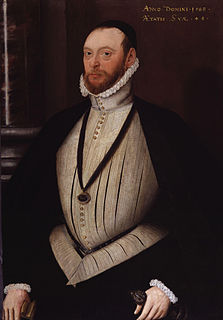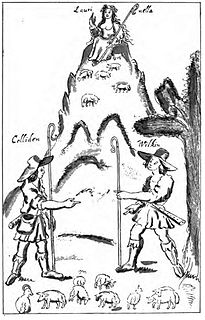Related Research Articles

William Kirby was an English entomologist, an original member of the Linnean Society and a Fellow of the Royal Society, as well as a country rector, so that he was an eminent example of the "parson-naturalist". The four-volume Introduction to Entomology, co-written with William Spence, was widely influential.

Thomas Wentworth, 2nd Baron Wentworth was an English peer, courtier, administrator and military commander during the reigns of Edward VI, Mary and Elizabeth. His reputation suffered through the surrender of Calais in 1558, which occurred under his command.

William Basse (c.1583–1653?) was an English poet. A follower of Edmund Spenser, he is now remembered principally for an elegy on Shakespeare. He is also noted for his "Angler's song", which was written for Izaak Walton, who included it in The Compleat Angler.

False Folio is the term that Shakespeare scholars and bibliographers have applied to William Jaggard's printing of ten Shakespearean and pseudo-Shakespearean plays together in 1619, the first attempt to collect Shakespeare's work in a single volume. There are only two complete extant copies. One is part of the collection of the Folger Shakespeare Library in Washington, DC. The other is held in the Special Collections at Texas Christian University in Fort Worth, Texas.

Thomas Wentworth, 1st Baron Wentworth and de jure6th Baron le Despencer, PC was an English peer and courtier during the Tudor dynasty.

Sir Philip Wentworth of Nettlestead, Suffolk was an English knight and courtier. Wentworth was a great-grandfather of Jane Seymour, third wife of King Henry VIII, and was beheaded at Middleham, Yorkshire.

Sir Owen Hopton was an English provincial landowner, administrator and MP, and was Lieutenant of the Tower of London from c. 1570 to 1590.
Francis Sabie was an English poet.
John Mathew Gutch (1776-1861) was an English journalist and historian.

George Frost (1754–1821) was an English landscape painter who lived in Ipswich, Suffolk, England.
Thomas Gainsford was an author and news editor.

Edmund Withypoll, Esquire, of London, of Walthamstow, Essex, and of Ipswich, Suffolk, was an English merchant, money-lender, landowner, sheriff and politician, who established his family in his mother's native county of Suffolk, and built Christchurch Mansion, a distinguished surviving Tudor house, as his Ipswich home.
John Marckant or Markant was an English clergyman and author. He was the vicar of Great Clacton in Essex from 1559 until his death. But his fame rests on the claim that he was the author of several poems in The Whole Book of Psalms.
James Calthorpe of Ampton who was Sheriff of Suffolk, in 1656, during the Protectorate of Oliver Cromwell, by whom he was knighted at Whitehall, 10 December, in the same year.
Reynolds Calthorpe of Elvetham in Hampshire was a Whig Member of Parliament for Hindon.
Edward White was a London printer and stationer whose career spanned a period of over forty years. His shop in the booksellers' district of St Paul's Churchyard was at the Sign of the Gun, where he sold many anonymous works as well as works by Thomas Kyd, Robert Greene, Anthony Munday and Christopher Marlowe. Between 1594 and 1611 he sold all three quartos of William Shakespeare's Titus Andronicus.

The Belstead Brook Hotel in Ipswich, Suffolk is a building of historical significance. It was originally a 16th-century hunting lodge but was used later as a family residence. The property was then converted to a hotel which now provides accommodation and restaurant facilities. It also caters for special events particularly weddings.

Joshua Kirby, often mistakenly called John Joshua Kirby, was an English 18th-century landscape painter, engraver, writer, draughtsman and architect famed for his publications and teaching on linear perspective based on Brook Taylor's mathematics.

The National Agricultural Labourers Union (NALU) was a trade union representing farm workers in Great Britain.

Ipswich Greyfriars was a mediaeval monastic house of Friars Minor (Franciscans) founded during the 13th century in Ipswich, Suffolk. It was said conventionally to have been founded by Sir Robert Tibetot of Nettlestead, Suffolk, but the foundation is accepted to be set back before 1236. This makes it the earliest house of mendicant friars in Suffolk, and established no more than ten years after the death of St Francis himself. It was within the Cambridge Custody. It remained active until dissolved in the late 1530s.
References
![]() This article incorporates text from a publication now in the public domain : Pollard, Albert Frederick (1900). "Yates, James (fl.1582)". In Lee, Sidney (ed.). Dictionary of National Biography . Vol. 63. London: Smith, Elder & Co. p. 294.
This article incorporates text from a publication now in the public domain : Pollard, Albert Frederick (1900). "Yates, James (fl.1582)". In Lee, Sidney (ed.). Dictionary of National Biography . Vol. 63. London: Smith, Elder & Co. p. 294.